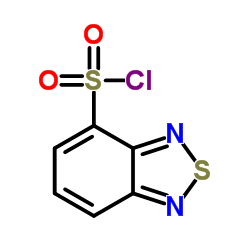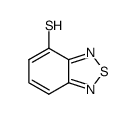73713-79-8
| 中文名 | 苯并[1,2,5]噻二唑-4-磺酰氯 |
|---|---|
| 英文名 | 2,1,3-benzothiadiazole-4-sulfonyl chloride |
| 中文别名 | 2,1,3-苯并噻二唑-4-磺酰氯 |
| 英文别名 |
MFCD00068049
2,1,3-Benzothiadiazole-4-sulphonyl chloride 2,4-DICHLOROBIPHENYL 4-Chlorosulfonyl-2,1,3-benzothiadiazole 2,1,3-benzothiadiazole-4-sulfonylchloride Benzo-2,1,3-thiadiazole-4-sulphonyl chloride Benzo[c][1,2,5]thiadiazole-4-sulfonyl chloride 2,1,3-Benzothiadiazole-4-sulfonyl chloride benzo[1,2,5]thiadiazole-4-sulfonyl chloride T56 BNSNJ FSWG benzo[2,1,3]thiadiazole-4-sulfonyl chloride 2,1,3-Benzothiadiazole,4-chlorosulfonyl 2,1,3-Benzothiadiazole, 4-chlorosulfonyl- Benzo-2,1,3-thiadiazole-4-sulfonyl chloride 2,1,3-Benzothiadiazol-4-sulfonyl chloride |
| 密度 | 1.7±0.1 g/cm3 |
|---|---|
| 沸点 | 359.4±15.0 °C at 760 mmHg |
| 熔点 | 148 °C |
| 分子式 | C6H3ClN2O2S2 |
| 分子量 | 234.683 |
| 闪点 | 171.2±20.4 °C |
| 精确质量 | 233.932449 |
| PSA | 96.54000 |
| LogP | 1.75 |
| 蒸汽压 | 0.0±0.8 mmHg at 25°C |
| 折射率 | 1.684 |
| 储存条件 | 存放在密封容器内,并放在阴凉,干燥处。储存的地方必须上锁,钥匙必须交给技术专家和他们的助手保管。储存的地方必须远离氧化剂。 |
| 稳定性 | 远离氧化物,碱。 |
| 分子结构 | 1、 摩尔折射率:51.69 2、 摩尔体积(m3/mol):136.1 3、 等张比容(90.2K):403.0 4、 表面张力(dyne/cm):76.8 5、 极化率(10 -24cm 3):20.49 |
| 计算化学 | 1.疏水参数计算参考值(XlogP):1.8 2.氢键供体数量:0 3.氢键受体数量:5 4.可旋转化学键数量:1 5.互变异构体数量:无 6.拓扑分子极性表面积96.5 7.重原子数量:13 8.表面电荷:0 9.复杂度:290 10.同位素原子数量:0 11.确定原子立构中心数量:0 12.不确定原子立构中心数量:0 13.确定化学键立构中心数量:0 14.不确定化学键立构中心数量:0 15.共价键单元数量:1 |
| 更多 | 1. 性状:固体。 2. 密度(g/mL,25/4℃):未确定 3. 相对蒸汽密度(g/mL,空气=1):未确定 4. 熔点(ºC):148 5. 沸点(ºC,常压):未确定 6. 沸点(ºC,5.2kPa):未确定 7. 折射率:未确定 8. 闪点(ºC):未确定 9. 比旋光度(º):未确定 10. 自燃点或引燃温度(ºC):未确定 11. 蒸气压(kPa,25ºC):未确定 12. 饱和蒸气压(kPa,60ºC):未确定 13. 燃烧热(KJ/mol):未确定 14. 临界温度(ºC): 未确定 15. 临界压力(KPa): 未确定 16. 油水(辛醇/水)分配系数的对数值:未确定 17. 爆炸上限(%,V/V):未确定 18. 爆炸下限(%,V/V):未确定 19. 溶解性:未确定。 |
Synonym: Section 2 - COMPOSITION, INFORMATION ON INGREDIENTS
Risk Phrases: 34 Section 3 - HAZARDS IDENTIFICATION EMERGENCY OVERVIEW
Causes burns.Moisture sensitive. Potential Health Effects Eye: Causes eye burns. Skin: Causes skin burns. Ingestion: Causes gastrointestinal tract burns. Inhalation: Causes chemical burns to the respiratory tract. Chronic: Not available. Section 4 - FIRST AID MEASURES Eyes: Immediately flush eyes with plenty of water for at least 15 minutes, occasionally lifting the upper and lower eyelids. Get medical aid immediately. Skin: Get medical aid immediately. Immediately flush skin with plenty of water for at least 15 minutes while removing contaminated clothing and shoes. Ingestion: Do not induce vomiting. Get medical aid immediately. Inhalation: Get medical aid immediately. Remove from exposure and move to fresh air immediately. If not breathing, give artificial respiration. If breathing is difficult, give oxygen. Notes to Physician: Treat symptomatically and supportively. Section 5 - FIRE FIGHTING MEASURES General Information: As in any fire, wear a self-contained breathing apparatus in pressure-demand, MSHA/NIOSH (approved or equivalent), and full protective gear. Extinguishing Media: Use foam, dry chemical, or carbon dioxide. Section 6 - ACCIDENTAL RELEASE MEASURES General Information: Use proper personal protective equipment as indicated in Section 8. Spills/Leaks: Vacuum or sweep up material and place into a suitable disposal container. Section 7 - HANDLING and STORAGE Handling: Do not breathe dust, vapor, mist, or gas. Do not get in eyes, on skin, or on clothing. Use only in a chemical fume hood. Storage: Store in a cool, dry place. Store in a tightly closed container. Corrosives area. Store under an inert atmosphere. Section 8 - EXPOSURE CONTROLS, PERSONAL PROTECTION Engineering Controls: Facilities storing or utilizing this material should be equipped with an eyewash facility and a safety shower. Use adequate ventilation to keep airborne concentrations low. Exposure Limits CAS# 73713-79-8: Personal Protective Equipment Eyes: Not available. Skin: Wear appropriate protective gloves to prevent skin exposure. Clothing: Wear appropriate protective clothing to prevent skin exposure. Respirators: Follow the OSHA respirator regulations found in 29 CFR 1910.134 or European Standard EN 149. Use a NIOSH/MSHA or European Standard EN 149 approved respirator if exposure limits are exceeded or if irritation or other symptoms are experienced. Section 9 - PHYSICAL AND CHEMICAL PROPERTIES Physical State: Solid Color: pale yellow Odor: Not available. pH: Not available. Vapor Pressure: Not available. Viscosity: Not available. Boiling Point: Not available. Freezing/Melting Point: 147 - 150 deg C Autoignition Temperature: Not available. Flash Point: Not available. Explosion Limits, lower: Not available. Explosion Limits, upper: Not available. Decomposition Temperature: Solubility in water: Specific Gravity/Density: Molecular Formula: C6H3ClN2O2S2 Molecular Weight: 235 Section 10 - STABILITY AND REACTIVITY Chemical Stability: Not available. Conditions to Avoid: Incompatible materials, exposure to moist air or water. Incompatibilities with Other Materials: Strong oxidizing agents, bases, alcohols, amines. Hazardous Decomposition Products: Hydrogen chloride, chlorine, nitrogen oxides, carbon monoxide, oxides of sulfur, carbon dioxide. Hazardous Polymerization: Has not been reported Section 11 - TOXICOLOGICAL INFORMATION RTECS#: CAS# 73713-79-8: DL0100000 LD50/LC50: Not available. Carcinogenicity: 2,1,3-Benzothiadiazole-4-sulfonyl chloride - Not listed by ACGIH, IARC, or NTP. Other: See actual entry in RTECS for complete information. Section 12 - ECOLOGICAL INFORMATION Section 13 - DISPOSAL CONSIDERATIONS Dispose of in a manner consistent with federal, state, and local regulations. Section 14 - TRANSPORT INFORMATION IATA Shipping Name: CORROSIVE SOLID, N.O.S.* Hazard Class: 8 UN Number: 1759 Packing Group: III IMO Shipping Name: CORROSIVE SOLID, N.O.S. Hazard Class: 8 UN Number: 1759 Packing Group: III RID/ADR Shipping Name: CORROSIVE SOLID, N.O.S. Hazard Class: 8 UN Number: 1759 Packing group: III Section 15 - REGULATORY INFORMATION European/International Regulations European Labeling in Accordance with EC Directives Hazard Symbols: C Risk Phrases: R 34 Causes burns. Safety Phrases: S 26 In case of contact with eyes, rinse immediately with plenty of water and seek medical advice. S 36/37/39 Wear suitable protective clothing, gloves and eye/face protection. S 45 In case of accident or if you feel unwell, seek medical advice immediately (show the label where possible). WGK (Water Danger/Protection) CAS# 73713-79-8: No information available. Canada None of the chemicals in this product are listed on the DSL/NDSL list. CAS# 73713-79-8 is not listed on Canada's Ingredient Disclosure List. US FEDERAL TSCA CAS# 73713-79-8 is not listed on the TSCA inventory. It is for research and development use only. SECTION 16 - ADDITIONAL INFORMATION N/A |
|
毒理学数据: 1 、急性毒性:小鼠(静脉)LD50:56mg/kg 由于食盐的LD50是3,000 mg/kg,BPA的急性毒性程度与食盐同。 生态学数据: 对水稍微有危害的,不要让未稀释或者大量产品接触地下水,水道或者污水系统。若无政府许可,勿将材料排入周围环境。 CHEMICAL IDENTIFICATION
HEALTH HAZARD DATAACUTE TOXICITY DATA
|
| 危害码 (欧洲) | C:Corrosive; |
|---|---|
| 风险声明 (欧洲) | R34 |
| 安全声明 (欧洲) | S26-S36/37/39 |
| 危险品运输编码 | 3261 |
| RTECS号 | DL0100000 |
| 包装等级 | III |
| 危险类别 | 8 |
| 海关编码 | 2934999090 |
|
~65% 
73713-79-8 |
| 文献:Belen'kaya, I. A.; Shulla, T. A. Chemistry of Heterocyclic Compounds (New York, NY, United States), 1989 , vol. 25, # 11 p. 1303 - 1307 Khimiya Geterotsiklicheskikh Soedinenii, 1989 , # 11 p. 1555 - 1558 |
|
~71% 
73713-79-8 |
| 文献:Dorogov, Mikhail V.; Filimonov, Sergey I.; Kobylinsky, Dmitry B.; Ivanovsky, Sergey A.; Korikov, Pavel V.; Soloviev, Mikhail Y.; Khahina, Maria Y.; Shalygina, Elena E.; Kravchenko, Dmitry V.; Ivachtchenko, Alexandre V. Synthesis, 2004 , # 18 p. 2999 - 3004 |
|
~71% 
73713-79-8 |
| 文献:Belen'kaya, I. A.; Shulla, T. A. Chemistry of Heterocyclic Compounds (New York, NY, United States), 1989 , vol. 25, # 11 p. 1303 - 1307 Khimiya Geterotsiklicheskikh Soedinenii, 1989 , # 11 p. 1555 - 1558 |
| 海关编码 | 2934999090 |
|---|---|
| 中文概述 | 2934999090. 其他杂环化合物. 增值税率:17.0%. 退税率:13.0%. 监管条件:无. 最惠国关税:6.5%. 普通关税:20.0% |
| 申报要素 | 品名, 成分含量, 用途 |
| Summary | 2934999090. other heterocyclic compounds. VAT:17.0%. Tax rebate rate:13.0%. . MFN tariff:6.5%. General tariff:20.0% |




